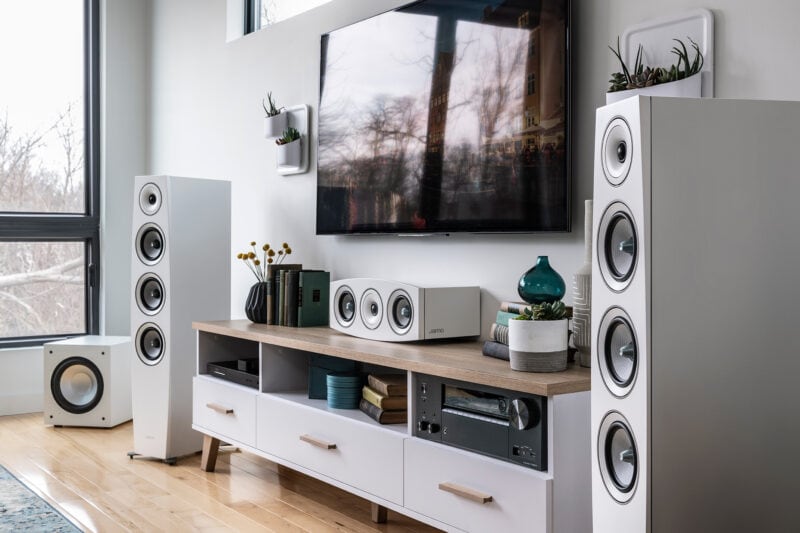What influences the equipment you buy? Make no mistake, none of us buy audio or musical instrument gear without being affected by past inspirations.
I suppose my earliest memory of being influenced by musical instruments resulted from being given a cheapo second-hand guitar to mess around with when I was about four or five years old. Little did I realise at the time that this would be a conduit to my future love and interest of all things musical. Nor did I appreciate the fact that it had been obtained from a local tip given to my ever-opportunistic grandfather who was always on the lookout for a bargain.
I loved that guitar. Black and red and assembled from the most basic laminated wood and hardware imaginable, but it captivated me nonetheless. I’m sure it’s a commonly shared experience, but somehow it ignited a subconscious passion for guitar, and for music and the wonderful places it could take you. I would sit for hours, pluck the strings in no particularly coordinated way and be hypnotised by their vibration and resonance. As the strings would individually oscillate in their captivating elliptical paths, I would wonder where, at which point in time the string actually was. (Check out this slow-motion video.) It seemed to be that at any point I would interrupt the motion, as if I could interrupt a dream-like movement, and make it tangible; tactile with the production of sound. I didn’t know it, but I was hooked on basic string theory (OK – I hold my hands up – a physicist I ain’t!)
Years later I came across the band Rush, and their 2112 album had kindred lyrics from part three of the title track entitled “Discovery” which went: “What can this strange device be? When I touch it, it gives forth a sound. It’s got wires that vibrate, and give music. What can this thing be that I found…?” It struck a chord with me not just because of my youth, but also because it was such an early album in the band’s career and it seemed like we would grow up together. A soundtrack to my youth? A big slice of it for sure.
In my early twenties, I got a part-time job as an assistant to the manager in a guitar shop. It started out as a natural extension of my frequenting the store every given Saturday, making cups of tea and hanging out. Customers would ask, “Do you work here?” and I thought I had better make myself useful rather than look like some kind of loafing slacker who could bring down the reputation of this oh-so cool-shop! Soon enough my endeavours were rewarded and I was taken on as staff for the Saturday retail pulse day (the busiest day of the week), which in turn grew into working more weekdays. After about three years I ended up running the shop and eventually bought the business as a going concern. Man – I was in my element!
The point to all this self-indulgent preamble is that working within the musical instrument retail business heavily influenced my choices in the audio gear I purchased. Here’s one example.
All the bass cabinets we sold (for bass guitar) were loaded with either eight, ten, or 15-inch woofers; occasionally someone might purchase a larger 18-inch cab. Rarely, a customer would buy a stereo rig for the stereo-output split pickups on their bass, such as the ones on the Jaydee basses built by John Diggins who makes instruments for Level 42’s Mark King among others. Some bass players loved the punchy sound of a 4×10 speaker cabinet, and, depending on the gig or the venue might choose to pair it with a 1×15 for even more serious bottom end heft. This was their sound. It employed a lot of power and drivers.

Occasionally a guitarist would buy two rigs for blending a straight clean and “dry” (without effects), and secondary “wet” (with chorus and/or delay) mix. Actually, my preference was for three channels, consisting of an overdriven stereo left and right wet mix, with a third dry rig or channel in the middle to maintain the integrity of some of the original unaltered clean guitar tone. This was great for maintaining note separation and definition in an otherwise time-modulated signal. You could hear ping-pong delays pass from the left to right rig and back again, full of saturated gain, but still the sound was well-defined overall thanks to the clean centre rig’s contribution to the mix.
I was influenced by many different rigs and powerful low-frequency sounds. When it came time to purchase an audio system, would I be content, then, with small bookshelf speakers or an array of many smaller drivers? No. Why? Because these speaker configurations generally just don’t move enough volume of air in pressurising the room in a manner that is anything like the equipment the musicians used for their live and recorded sounds.
An interesting observation I made was that musicians went all out for their tone – a personalised take on what sounded cool to them. Maybe they wanted something with “grunt,” or perhaps a sound that was both warm and bright, or perhaps rich and dark. Meanwhile, in a live context, much of the audience is swept along with the groove itself, the energy of the timing and tempo.
I also noted that the tone the musicians would achieve in the music shop could be very different than what the equipment produced in a live gig, for countless reasons besides volume levels or how hard the power amp stage was working. The sound of the room had a tremendous effect, and also whether the venue would be full of sound-absorbing people or not. Maybe the bass player wouldn’t even play through their amp and just decide to DI (direct input) their signal straight to the mixing desk and be done with it. Perhaps they’d mic their amp and use a combination of amp and miked sound. And then their rig would have to compete with the drummer and other instruments.
The point is that, despite all the potential obstacles, musicians and music lovers pay a lot of attention to their intimate experience with their sound and tone. When they are practising on their instrument, learning something new or jamming with mates, having a pleasing personal tone is motivational. It encourages and rewards your efforts. Similarly, when listening to a great stereo system, the engagement you feel with the music can move you emotionally, and maybe even evoke feelings you didn’t even know you had.
 Musical enjoyment is ultimately what it's all about. The Andover Audio Model One Turntable Music System.
Musical enjoyment is ultimately what it's all about. The Andover Audio Model One Turntable Music System.Here are some thoughts to ponder. When you consider how much time, effort, energy and research goes into the music the artist writes, the choice of the equipment they use, and yes, the size of the speakers they employ in their recordings, do you want to reproduce that to a good standard? You may well rightly argue it’s impossible to replicate the room the musicians were in along with all their gear[1], but in reality, with some simple decisions, and spending a little time and perhaps a modest amount of money, you can make a vast improvement in honoring more of those ingredients in improving the sound of your home hi-fi and optimising your listening room.
Getting the set up right for your room, effectively managing your bass and crossovers (if you have them in your system), adjusting your seating position and accommodating your room’s characteristics can be significant in getting you there. It can be easier than you think.
With a basic calibration microphone and some excellent free software called Room EQ Wizard or REW (often affectionately phonetically pronounced “roo”), you can see what is happening in your room and make changes accordingly. (For more detail, please read Adrian Wu’s article, “To Test or Not to Test, Part Three,” in Issue 127.)

When choosing gear, making listening comparisons between components (as I mentioned in “Totally Transparent,” Issue 132) is very helpful. That’s not to say that you can’t improve the sound of your equipment you already own. For example, as many experienced audiophiles know, you may find that your stereo system sounds better if you leave the power on all the time rather than turning it on just before you want to play through it. It’s not for me to make any environmental judgments on how you run your equipment but it could be a worthwhile experiment for you to try.
Back to influences and choosing audio equipment. Having been a musical instrument and amplifier retailer for many years, listening to the sound of actual instruments in real life and hearing what was important to the musicians was a huge influence on what stereo equipment I would buy, and what I will consider buying in the future.
 When the speakers sound right, the whole family likes it! Courtesy of Eikon Audio.
When the speakers sound right, the whole family likes it! Courtesy of Eikon Audio.I want sonic loyalty to the artist’s performance tones from my audio system, and after all, isn’t that what so many of us strive for in our hi-fi setups? I want audio components and setups that represent integrity to the musicians who crafted their signature sounds. This also applies to the listening room, which has such a bearing on the overall feel of the soundstage, and the presence and liveliness of the music. These were the factors which would determine where I would shell out my hard-earned cash. I know my own tonal preferences, what timbres I like to hear, how bright or not I like the sound, and what level of richness in the details suit my taste. To that end I rationalised that Yamaha would be a good way to go and perhaps their products would be more musically insightful than their competitors. After all, they make musical instruments, right?
In a coming interview with Yamaha, Russ will discuss how their music instrument manufacturing and digital signal processing technologies influence the design of both their stereo and consumer audio equipment.
[1] You can’t set up the same gear as the band and the recording studio in your listening room, but you can (at least when the pandemic is over) take some time to use your “sound judgment” to really listen the next time you’re hearing a band, performer or symphony orchestra live.
Header image: Jamo Concert 9 Series speaker system. From the Jamo Audio website.



